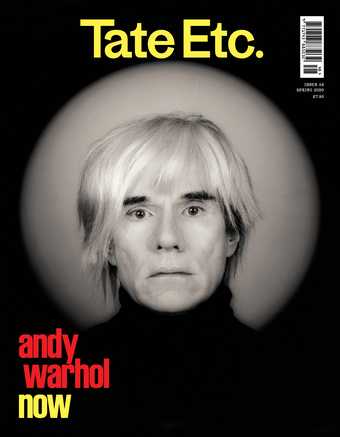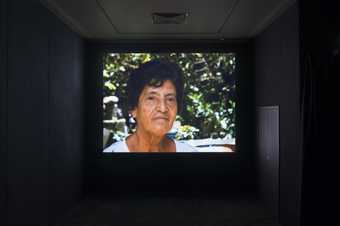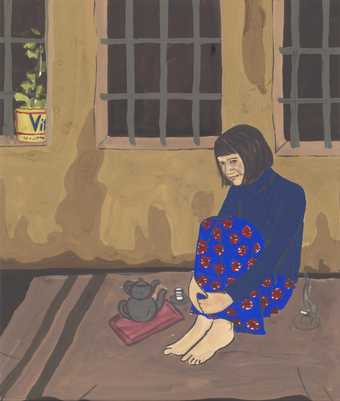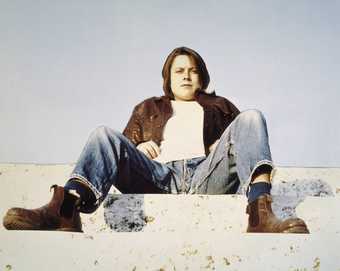
Vivian Suter painting at night outside one of her studios in Panajachel, Guatemala
Photo © Flavio Karrer
Born in Buenos Aires, Argentina, and educated in Basel in Switzerland, Vivian Suter (b1949) moved to Panajachel in Guatemala in 1982, where she has made a home with her mother, artist Elisabeth Wild, on the grounds of a former coffee plantation. Her studios are open-air wooden structures located amid lush rainforest, where large windows, doors and verandas bridge indoors and outdoors. Here, the backdrop of avocado and mango trees, banana plants, palms, vibrant flowers, and sounds of tropical birds serves as inspiration for Suter’s large abstract paintings, which she creates outdoors on untreated canvas. They are records of the passage of time and the environmental conditions in which they were made, and, occasionally, remnants of the surrounding landscape can also be found within them: volcanic or botanical matter congealed into batches of thick paint, for example, or random imprints of her dogs’ paws. She has said of her paintings: ‘They are geographical things … I want to keep them as near as possible to my surroundings, and put them, in that moment, into the painting.’
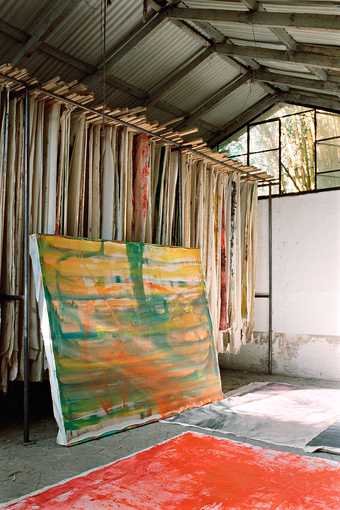
Storage and working spaces in the two studios that Suter has built in the Guatemalan rainforest
Photo © Flavio Karrer
The presentation of Nisyros (Vivian’s Bed) 2016–17 at Tate Liverpool is Suter’s first UK solo display and her largest installation to date, consisting of 53 brightly coloured canvases suspended in space. To coincide with this, Tate Etc. sent the artist some questions about her working day, her unique environment, and the tropical storms that led Suter to embrace nature as an active agent in the creation of her paintings.
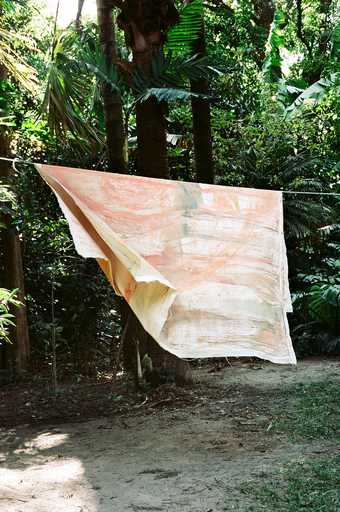
Storage and working spaces in the two studios that Suter has built in the Guatemalan rainforest
Photo © Flavio Karrer
TATE ETC. Could you describe the place where you live and the studios you have built there?
VIVIAN SUTER I live on the edge of a village on the mountainside, near Lake Atitlán, on part of an old coffee plantation that is wildly overgrown by trees and lush vegetation. I have two studios: one is on the mountain, where I do most of my painting, and the other, where I store and work with the finished paintings, is surrounded by banana trees.
TE How and when did you first come to this village, Panajachel?
VS I went on a trip to LA in 1982. From there I travelled to Mexico, visiting the ruins, and ended up in Guatemala, where I have stayed ever since.
TE How does the environment here influence your work?
VS The environment influences me very much. The light. The wind. Painting in the rain. The noises. The birds, dogs barking, the thunder, the rain, the church bell, music from afar, the booming of the folk festivals, voices – all of these noises are reflected on the mountain. And all of these environmental things find their way into my paintings in some way.
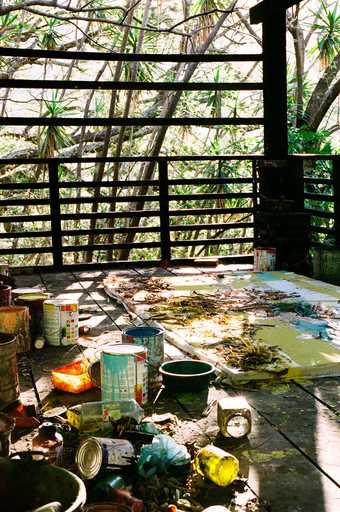
Storage and working spaces in the two studios that Suter has built in the Guatemalan rainforest
Photo © Flavio Karrer
TE What is your typical working day like?
VS I use the same stretchers over and over, so I take the newly finished paintings off and restretch new canvases on them every time I start a new painting. It’s like a daily dance. With the help of my assistants Don Tomas and Juan, I bring the paintings up and down the mountain. I prepare the materials I paint with; I cook the fish glue and take it up the mountain, where I choose my acrylic, oil and powder colours for the day. I try to paint every day. I prepare in the morning and paint all afternoon into the dark, without electric light. When I have finished I come down the mountain with a flashlight, a stick and the dogs. It is amazing that I make it back home in one piece.
TE Being so immersed in nature, were you affected by the catastrophic hurricanes that hit Guatemala in 2005 and 2010?
VS There were mudslides here. In 2005, the lower studio was flooded about a metre deep in mud. So all the paintings got wet and muddy, which seemed like a disaster when we first shovelled away the mud. But, as the paintings started to dry, I saw that the natural residue had left a sharp line across the canvases, and that the paintings underneath were still visible above this line. So I saw a new potential to incorporate this, and it unified the whole work. Since then, I have also started thinking and feeling differently about painting and the conception of my work. The experience has allowed me to see my paintings as living materials that are testament to the destruction, decay and regeneration of nature.
TE Were you influenced by anyone or anything in particular when you first became an artist?
VS I was influenced from early on by my mother, Elisabeth Wild, who is an artist – I was always surrounded by it.
TE Do the mosquitoes bother you when you are working?
VS Yes, the mosquitoes bother me, but there are not that many and it is not very hot here. There is more of a scorpion problem, especially in the windy season when they fall from the trees onto the roof and get into your shoes or even bed… Snakes also seem to like my house.
Vivian Suter is presented in the Wolfson Gallery, Tate Liverpool, until 15 March, curated by Kasia Redzisz, Senior Curator and Tamar Hemmes, Assistant Curator, Tate Liverpool. Supported by the Swiss Arts Council Pro Helvetia.

